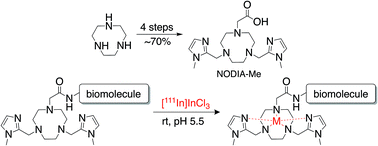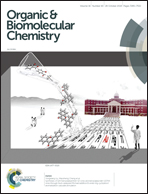Optimized synthesis and indium complex formation with the bifunctional chelator NODIA-Me†
Abstract
The bifunctional chelator NODIA-Me holds promise for radiopharmaceutical development. NODIA-Me is based on the macrocycle TACN (1,4,7-triazacyclononane) and incorporates two additional methylimidazole arms for metal chelation and an acetic acid residue for bioconjugation. The original two step synthesis was less than optimal due to low yields and the requirement of semi-preparative RP-HPLC purifications. Here, the overall yield for the preparation of NODIA-Me was improved two- to five-fold via two synthetic routes using different protection/deprotection techniques. This way, it was possible (1) to prepare of NODIA-Me on multi-gram scale and (2) to avoid time-consuming HPLC purifications. Inspired by recent results with nat/68Ga3+, preliminary studies on the radiolabeling properties and complex formation of NODIA-Me with nat/111In3+ were performed. Quantitative radiochemical yields were achieved at ambient temperature providing molar activities of ∼30 MBq nmol−1, which could be increased to ∼240 MBq nmol−1 at 95 °C. At r.t., pH 5.5 was optimal for 111In-labeling, but quantitative yields were also achieved in the pH range from 5.5 to 8.2, when the reaction temperature was increased. Stability tests of 111In complexes in vitro revealed high kinetic stabilities in serum and ligand challenge experiments, which is a consequence of the formation of rigid 1 : 1 indium chelates as shown by NMR studies in solution. In summary, the new synthetic routes afford the BFC NODIA-Me in high yields and on large scale. Further, 111In complexation experiments broaden the scope of our chelating system for radiopharmaceutical applications.

- This article is part of the themed collection: Supramolecular chemistry in OBC


 Please wait while we load your content...
Please wait while we load your content...